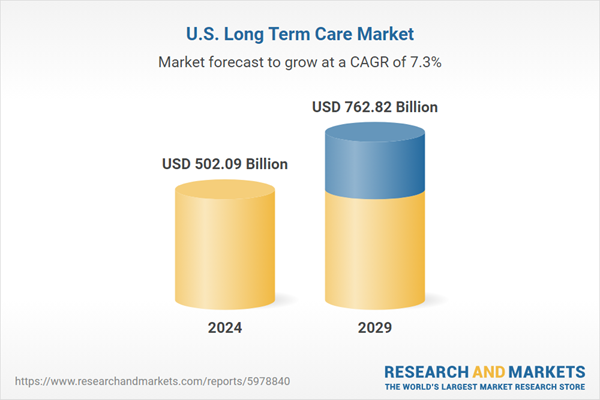Dublin, July 5, 2024 (GLOBE NEWSWIRE) — The report “United States Long Term Care Market, By Region, By Competition, Forecast & Opportunities, 2019-2029F” has been added to The Offer.
The US long-term care market was valued at $502.09 billion in 2023 and is expected to witness robust growth during the forecast period at a compound annual growth rate (CAGR) of 7.33% until 2029.
The U.S. long-term care market is experiencing significant change and growth due to a rapidly aging population, demographic shifts, and evolving healthcare needs. Long-term care encompasses a broad range of services and supports designed to help individuals who have difficulty performing daily activities due to chronic illness, disability, or the natural aging process. This market includes several sectors, including nursing homes, home health care, assisted living, and adult day care services.

One of the main drivers of the U.S. long-term care market is the growing older population. As people live longer, demand for long-term care services continues to rise, especially in developed countries where population aging is more pronounced. This demographic shift has led to an increase in the number of individuals seeking assistance with activities of daily living, such as bathing, dressing, and meal preparation.
The population in the Midwest, including the aging population, impacts the demand for long-term care services. If the region has a higher proportion of elderly people, the demand for long-term care services may increase, leading to market growth. The availability and quality of healthcare facilities, including long-term care facilities and nursing homes, also influence the growth and dominance of the market in a particular region.
Government policies and regulations related to healthcare and long-term care affect market dynamics. The Midwest has implemented policies that favored the growth of long-term care services, which contributes to their dominance. Economic conditions in the region, such as income levels and employment opportunities, favor the ability of individuals and families to afford long-term care services.
In addition to demographic factors, changing healthcare preferences are also influencing the market. Many seniors and their families prefer long-term care in the comfort of their own homes, fueling the growth of home healthcare services and the development of innovative technologies that enable remote monitoring and care. This trend toward home care is also driven by the desire to maintain seniors’ independence and improve their overall quality of life.
The U.S. long-term care market is highly fragmented. Various players, including government agencies, private providers, and nonprofit organizations, offer their services. Government initiatives and policies play a crucial role in shaping the market. Many countries are working to build a sustainable system for providing long-term care services to their aging populations.
Technological progress and telemedicine
Technological advancements and the integration of telehealth services have proven to be powerful drivers that are significantly boosting the U.S. long-term care market. These innovations are changing the way long-term care services are delivered and improving the overall patient experience.
Telemedicine, enabled by advanced technology, allows healthcare professionals to remotely monitor and assess patients, provide timely interventions, and ensure continuity of care. This has several implications for the long-term care market. First, it improves accessibility, especially for individuals in remote or underserved areas who may have difficulty receiving in-person care. Patients and caregivers can connect with healthcare providers without having to visit the office in person, reducing travel and wait times.
The Midwest emerged as the dominant region in the U.S. long-term care market in 2023, holding the largest market share. The composition of telemedicine increases the efficiency of long-term care services. Routine checkups, medication management, and symptom monitoring can be performed remotely, minimizing the need for frequent in-person visits. This not only saves time for patients and healthcare providers, but also reduces the burden on already understaffed facilities.
In addition, technological advances have given rise to wearable devices, mobile health applications and electronic health records that allow patients and their caregivers to track and share health data with healthcare professionals. This data can provide valuable insights into a patient’s condition, enabling more proactive care management.
Home care, which is becoming increasingly popular among older people and their families, benefits enormously from these technological advances. Home care services are now equipped with remote monitoring and communication tools, allowing healthcare professionals to intervene and provide timely support while patients remain in the comfort of their own home. This meets the desire of many seniors to grow old in their own homes and maintain their independence.
Integration of services and care coordination
Integration of services and coordination of care is a critical factor driving the U.S. long-term care market. This trend involves creating a seamless continuum of care that facilitates patient transitions between different levels of care, from hospitals to nursing homes, home care, assisted living, and beyond. This integrated approach ensures that individuals receive consistent, well-coordinated care throughout their healthcare journey, significantly improving the quality of long-term care services.
The benefits of service integration and care coordination are many. They reduce fragmentation of care and ensure that patients do not fall through the cracks when moving between care settings. This is especially important for individuals with complex care needs, such as those suffering from chronic diseases or age-related conditions. By ensuring a smooth handoff between healthcare providers and care settings, patients experience fewer interruptions in their care, ultimately leading to better health outcomes.
In addition, service integration increases the efficiency of long-term care. By optimizing the flow of information and services, providers can reduce redundancies and administrative burdens. Care teams can collaborate more effectively, share important patient information, and ensure that care plans are consistent and well-coordinated. This level of efficiency not only improves the quality of care, but also optimizes resource allocation.
Integrating services and care coordination also provides a patient-centered approach, giving patients more control over their care journey and enabling them to make informed decisions about their health. By putting patients at the center of the care process, they can set their goals, preferences and priorities, resulting in a more personalized and responsive care experience.
In addition, this trend reduces the burden on caregivers and family members, who often play a critical role in the long-term care of their loved ones. Clear communication and smooth transitions between care settings help caregivers understand the care plan and their responsibilities, alleviating the stress and confusion associated with long-term care.
Key Features:
| Report Attribute | details |
| Number of pages | 85 |
| Forecast period | 2024 – 2029 |
| Estimated market value (USD) in 2024 | 502.09 billion US dollars |
| Projected market value (USD) until 2029 | 762.82 billion US dollars |
| Annual growth rate | 7.3% |
| Regions covered | United States |
Report scope:
In this report, the US Long-Term Care market has been segmented into the following categories in addition to the industry trends detailed below:
Important market participants
- Brookdale Senior Living, Inc.
- Knight Health Holdings, LLC
- Fast Family, Inc.
- Atria senior living group
- Sunrise Senior Living, LLC
- Extenticare, Inc.
- Senior living in Sonida
- Diversicare Healthcare Services Inc.
- Genesis Healthcare
- We are proud of our achievements and look forward to welcoming you back soon.
Long-term care market in the United States, by service:
- Home care
- Hospice and palliative care
- Care
- Assisted living
- Other
Long-term care market in the USA, by payer:
- Public
- Private
- Out of the bag
Long-term care market in the USA, by region:
- Northeast
- Middle West
- west
- South
For more information about this report visit https://www.researchandmarkets.com/r/43yntr
About ResearchAndMarkets.com
ResearchAndMarkets.com is the world’s leading source of international market research reports and market data. We provide you with the latest data on international and regional markets, key industries, the top companies, new products and the latest trends.
-
US long-term care market



